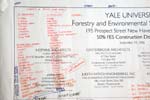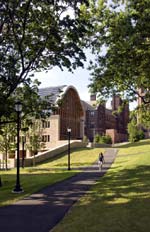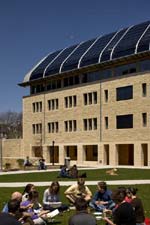
|

|
|
Home Site Search Contact Us Subscribe
|
|
|
Proper English, as in "Crikey, It's the Loo!" What in the Sam Hill are lippings, we beseeched? Answer: trim. Conversely, our colleagues from across the pond were anxious to know who, precisely, Mr. Sam Hill would be. By By Jim Coan July 2, 2010 Editor’s note: British-isms in the text, such as theatRE, are bolded; translations, when deemed necessary, follow in parenthesis – for example, bingo wings (flabby underarms, associated with elderly denizens of gaming parlors).
Our guide, a tiptop British architect from Hopkins Architects of London, was showing us Yanks, Mark Simon and me of Centerbrook, several buildings that her firm designed in Nottingham, England (yes, as in “Sheriff of”). Centerbrook and Hopkins would be working together on Kroon Hall, the new home of Yale’s School of Forestry and Environmental Studies. Within our half of the collaboration, Centerbrook was tasked with, among other things, translating British architecture into an American context.
I was aware that Hopkins’ portfolio bristled with impressive green architecture – vegetated roofs, mixed-mode ventilation, wind cowls, and the like – but our guide kept referring to the Plant Room on the roof. No greenery or greenhouse, however, was in evidence up there.
After three mentions, I had to ask. It turns out she was referring to the Mechanical Equipment Room, or MER, as we call it stateside. The difference between our two cultures, architecturally speaking, would prove to be greater than I had imagined. It was all a tad dodgy (tricky or suspect) at first.
Yale had selected Hopkins out of six shortlisted firms known for their experience in sustainable design (Centerbrook was also shortlisted). Kroon Hall would be a symbol of Yale’s commitment to the environment and achieve the highest levels of sustainability, a LEED Platinum rating. Because Hopkins had only built one project in the United States, the university wanted an experienced American firm to assist as the Executive Architect. So the marriage was arranged between us and the Brits.
Hopkins is known for designing low energy, high performance buildings, with a commitment to an honest expression of materials in a modern idiom, using systems, materials, and detailing developed in Europe, but new to the U.S. market. One of our tasks was to make plans and documents comprehensible for American contractors and suppliers. This entailed translating Brit-Lish into Amer-English.
Mind the Gap! (Watch Your Step, More or Less)
I thought it would be easy at first. Centerbrook has done some international work, and I have travelled a fair bit throughout England and Europe. I fancied that I was familiar with British-isms: WCs (bathrooms), lifts (elevators), colours, carparks (parking lots), smashing (jolly good), to name a few. But when it came to architectural terms, there was a whole new lexicon to master. We, and the project, could easily have fallen through the gap.
What in the Sam Hill are lippings, we beseeched? Answer: trim. Conversely, our colleagues from across the pond were anxious to know who, precisely, Mr. Sam Hill would be.
To compound matters, the Kroon Hall team included architects and engineers from Arup and atelier ten, each sporting a variety of accents from throughout the former empire, among them various American dialects. Also, because construction practices, procurements processes, and tight budgets and schedules would not allow a typical Hopkins building here, adaptations had to be made. Bespoke (custom made) elements were limited, so noble substitutions were found for Hopkins favourite items, while at the same time we were educating local contractors on the fundamentals of Brit-Lish: fittings (fixtures), skirtings (base trim), totems (bollards, or short vertical posts), and a bit of kit (equipment).
Cockups (Blunders) and Silly Buggers (Foolish or Irritating People)
To avoid committing, or being the abovementioned, we decided early on that our Title Sheet for Construction Documents should include a British-to-American Terminology Legend. This included 35 terms used by Hopkins and Arup in their drawings followed by the closest American translation, plus those blinking (damned) metric units. After a while we got the hang of it – 100 millimeters equals a little less than four inches. A wee bit is a quarter of an inch, or thereabouts, close enough. A pint of bitter is way bigger than a pint of Bud. We took to keeping a running list of all unknown terms as they came up, not just the architecturally-related ones. Some were a wee facety (a little rude).
Local Cuisine
We had to eat while we were in the United Kingdom, where we ingested succulent delicacies like Treacle Sponge (Steamed Sponge Cake with syrup or molasses cooked on top, often served with hot custard) and Spotted Dick (Steamed Suet Pudding containing dried fruit, usually currants, commonly served with custard). And you thought suet was for the birds! I’ll never forget mushy peas and rocket (a porridge dish and arugula), or nose and tail (often accompanied by jellied eels is all you need to know). We Centerbrookians will always have Fitzrovia, where we ingested pie (meat, not fruit) and pudding (dessert) at a friendly boozer (pub).
A Proper Aedifice
For all that potential confusion (and indigestion), the completed building turned out to be a spiffing (excellent) synthesis of the two cultures. Yale accomplished its goal of erecting a flagship building equal to its environmental ambitions. Hopkins was satisfied that Kroon Hall aptly represented its design and sustainable philosophies. For Centerbrook, not only was it a great opportunity to work on a significant piece of architecture, but it was also a chance to participate in a cross-cultural exchange of ideas and methodologies – a touch of Uncle Sam here, and a good bit of John Bull there.
Brilliant! (cool, awesome, sweet!).
Jim Coan is the Director of Architectural Practice and Building Science at Centerbrook Architects. He has been the Project Manager for a number of the firm’s larger projects including Kroon Hall at Yale University. Only on rare occasions in his career has Jim found it necessary to use a dictionary to translate architectural terms.
Centerbrook Architects serves a diverse clientele, from universities and independent schools to arts organizations, businesses, municipalities, religious congregations, and homeowners. Founded in 1975, the Connecticut firm is housed in a renovated19th-century factory complex and generates 40% of its energy needs on site via hydro, solar, and geothermal systems. A recipient of the AIA 1998 Architecture Firm Award, Centerbrook has incorporated conservation or renewable energy features in more than 50 projects. |
(click on pictures to enlarge)  Centerbrook Architects Preliminary draft of UK-US glossary  Centerbrook Architects The final version  Derek Hayn, Centerbrook Kroon Hall, Yale University  Morley von Sternberg Kroon Hall  Morley von Sternberg Kroon Hall |
© 2010 ArchNewsNow.com